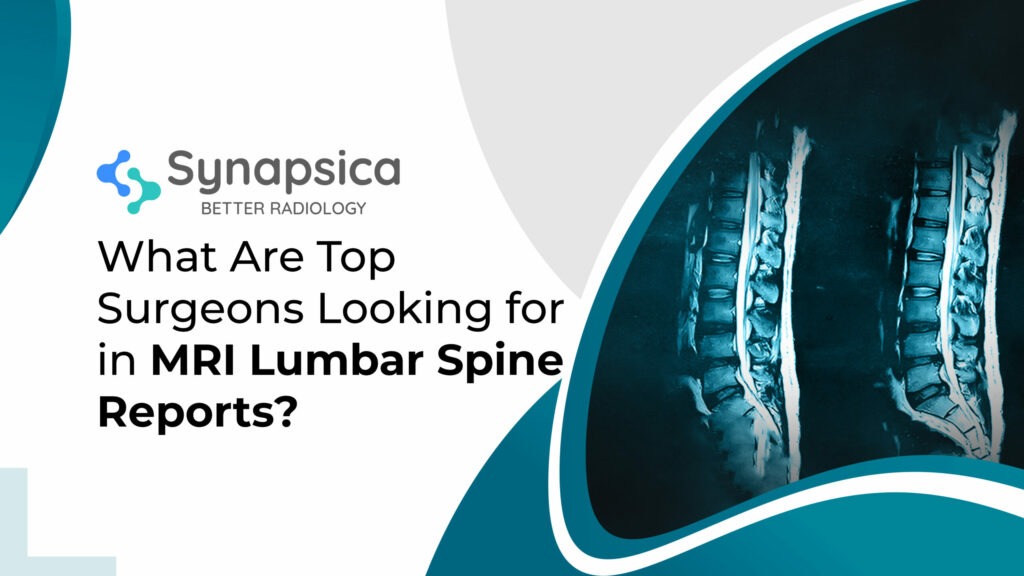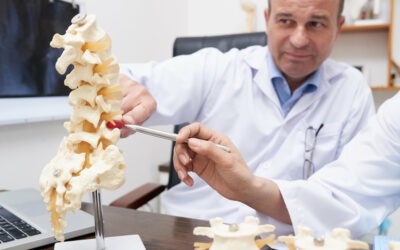
As a radiologist, how many times have you seen surgeons referring to MRI Lumbar Spine or other reports before surgeries?
Is it – often, rare, or never?
If your answer is often, then you are probably preparing reports of clinical value. If your answer is any of the other two, then this article is for you.
Almost all diagnoses are confirmed using medical imaging today. Yet, radiology reports seem to be of only partial value to surgeons. The common belief in the medical field is that surgeons don’t refer to radiology reports and reach out for images directly and numerous studies back the belief.
For instance, a study conducted by NCBI to understand the attitude of orthopedic surgeons toward radiology reports posited that “the majority of orthopedic surgeons are often not reading radiology reports” and highlighted the need for improved interdisciplinary collaboration.
Not just reports, even leading radiologists state the same, and claim that radiology reports are monotonous and haven’t been up to the expectations of surgeons.
Dr.Sriram Rajan, one of India’s leading MSK radiologists, upfront stated that “Radiology reports haven’t changed much in the last 40 to 50 years and don’t record clinically relevant information.”
What do surgeons mean by clinical value and why is it important?
More than a report, radiology reports act as a communication tool among clinicians. Any minute detail recorded in the report can alter the course of treatment or surgery entirely. Hence, a radiology report must convey the actual message to physicians and surgeons.
On the contrary, the unstructured and subjective nature of radiology reports has failed to convey the actual message, making them less clinically valuable for surgeons in most cases. Consider this – an MRI report of the lumbar spine states confirmation of disc herniation at L2, highlighting moderate severity. But what does moderate actually imply? That the disc herniation is 2mm? or is it 4 mm?
Subjective descriptions of pathologies may lead to incorrect treatment and surgical plans.
On the other hand, objective reports help in choosing appropriate surgery options for a herniated disc. For example, a radiology report stating disc herniation with the actual measure of the herniated disc, say 3 mm which indents and causes spinal cord edema, will let the surgeon opt for minimally invasive procedures like endoscopic microdiscectomy instead of considering conservative therapy.
Here’s what surgeons look for in MRI Lumbar Spine Reports
Orthopedic surgeons look for a concise and clear radiology report that is in a structured format and consistent, providing clarification (with quantification of pathologies) about the confirmation of a clinical diagnosis and highlighting differentials and recommendations. Also, adding key images to a structured report will help them visualize the anatomy they are going to operate upon.
Following is a list of elements that orthopedic surgeons look for in a report:
* Reporting structure
Structured reports have proven to be more effective in improving the communication of findings and enabling ease of reading and comprehension. Besides assisting in clinical decision-making, structured reports and standard nomenclatures help in mitigating errors.
* Findings/impressions
Most surgeons confess that they do not go through the whole report, but rather only look at the impression section as key images always help them visualize the extent of pathology along with quantification. Hence, the content of the impression section should contain all important information, including the explanations of the correlation of patient symptoms at the anatomical site with likely pathological conditions.
* Quantitative comparison
When a repeat scan is ordered based on clinical indications are only useful if a quantified comparison is present. Hence, subjective comparisons should be replaced with quantitative comparisons. Also, quantitative comparisons help in better understanding the progression of the disease.
* Incidental findings
Incidental findings are often unrecorded in radiology reports as they might seem insignificant at that moment. But incidental findings may play a major role in deciding the course of management, avoiding complications during and after surgery. Hence, it is imperative to record any incidental finding, regardless of its timely insignificance to a particular condition or pathology.
* Follow-up suggestions
Adding a radiologist’s recommendations/suggestions on follow-up imaging or testing studies (eg. contrast studies, other modalities, or a biopsy) will help the referring orthopedic surgeon for considering further clinically relevant investigations of suspicious or incidental findings in the exam.
* Subspecialty reporting
This is highly significant in the case of subspecialty orthopedic conditions. For instance, some inflammatory processes can mimic age related or neoplastic changes. Since the treatment approach varies for both conditions, it is imperative to be sure of the condition – whether it is an inflammatory or neoplastic process or a structural aging process; and a subspecialist opinion can help distinguish the conditions.
* Information about the interpreting radiologist
Most surgeons state that direct communication and collaboration is more effective, particularly in cases of doubtful diagnoses. For example, suspicions of infective and neoplastic processes can be properly clarified when the surgeon connects with the interpreting radiologist. Similarly, in cases of injury, direct interaction with radiologists will help surgeons formulate a better operative approach.
Hence, adding information about the interpreting radiologist in the radiology report is paramount.
AI in radiology reporting
The AI buzz has been going around the radiology community for a couple of years now. Most healthcare providers are concentrating on the use of AI in diagnostic imaging given the growing challenges of medical imaging in the big data era.
Studies show that besides helping in reading scans and detecting deformities, AI can also help in transcribing the findings into text documents.
Here’s how AI can help in radiology reporting:
*Reduces errors and improves access
Healthcare institutions spend nearly 20-30% of their revenue on radiology reporting. Even then the error rates in radiology reporting haven’t dropped. The day-to-day error rate in radiology reporting is estimated to be around 3-5%.
With the help of AI, radiologists can provide timely reports with minimal errors. AI-powered tools can help in maintaining report consistency and longitudinal tracking, thus enabling surgeons to easily get access to a patient’s history.
*Reduce surgical risks
AI can help in the quick generation of objective reports, enabling
healthcare providers reduce surgical risks due to missed findings, transcription errors, delayed results, and incomplete records.
Surgical errors are soaring like never before. In the U.S. alone, surgical errors occur over 4000 times a year. And in surgeries, even the slightest mistake can cost a patient’s quality of life, or even worse their own.
Hence, it is high time for healthcare providers to incorporate all means necessary to reduce surgical errors which are majorly driven by poor quality subjective reports.
And AI could be an appropriate solution to the problem. Engineered to empower radiologists and help the healthcare industry to provide better patient care, Synapsica’s AI-driven radiology tools can read radiology images thoroughly and generate objective reports, in just a click.
For instance, Spindle – an AI-powered reporting assistant for spine MRIs – can automatically detect deformities in images and create quantitative reports with just a click. The spindle has also proved to reduce reporting errors by 28%.

Categories
- Insurance 1
- Machine Learning 1
- PACS 3
- Radiology 25
- Spindle 10
- SpindleX 8
- Spine Health 5
- Spine Reporting 4
- Technology 7
- Teleradiology 2




